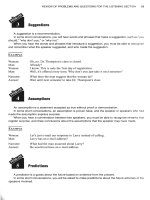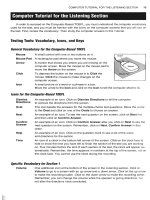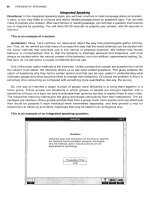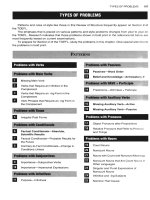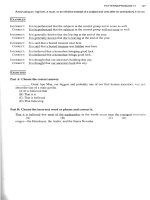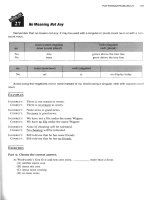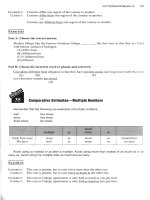Tài liệu How to prepare for the toefl part 66 docx
Bạn đang xem bản rút gọn của tài liệu. Xem và tải ngay bản đầy đủ của tài liệu tại đây (729.74 KB, 10 trang )
MODEL TEST MOMPUTER-ASSISTED TOEFL
653
Let me write Elderhostel on the board for you. Elderhostel.
To date, hundreds of thousands of students from sixty to one hundred years old have partici-
pated in Elderhostel. Students usually live in dormitories, eat in cafeterias, and attend social,
recreational, and cultural functions. All services available to students during the academic year
are offered to Elderhostel students. Registration fees vary from as little as twenty dollars to
as much as three hundred dollars, excluding books and transportation to the campus or commu-
nity site. For many senior citizens, Elderhostel offers the opportunity for lifelong learning,
companionship, and fun.
If you know someone sixty years old or older and you think they might enjoy learning, call
your local college. There is probably an Elderhostel program right in your community.
(
Now get ready to answer the questions
(
Audio
39.
What is Elderhostel?
Answer
(C) "One of the most successful educational programs for adults is the Elderhostel.
. .
.
"
Choice
(A)
is not correct because the classes are taught by highly qualified faculty at the host college, not by
retired professors. Although Elderhostel was originally a summer program, Choice
(B)
is not
correct because it is now offered year round. Choice
(D)
is not correct because Elderhostel
is
an
educational program with travel included, not a travel program.
Audio
40.
Which of the statements is true of Elderhostel?
Answer
(B)
(D)
"Although courses are not offered for credit, and no exams are required, the classes are
taught by highly qualified faculty at the host college." Choice (A) is not correct because the cours-
es are not offered for credit. Choice (C) is not correct because Elderhostel is for people over the age
of sixty.
Audio
41.
Which of the people in the picture would most probably be enrolled in an Elderhostel program?
Answer
(C) "Elderhostel [is] designed for students over the age of sixty." Choice (C) is a person sixty years
or older. The other people in the pictures, Choices (A),
(B),
and
(D),
are too young to enroll in
Elderhostel.
Audio
42.
What should you do if you are interested in finding out more about Elderhostel?
Answer
(B)
". . .
call your local college." Choices
(A),
(C),
and
(D)
are not mentioned and may not be con-
cluded from information in the talk.
654
EXPLANATORY ANSWERS AND AUDIO SCRIPTS
Audio Lecture
Narrator: Listen to part of a lecture in an earth science class. The professor will talk about
pyrite.
I
will be putting another specimen in the mineral lab for you after today's lecture. It is pyrite,
also known as iron disulfide, but more commonly called fool's gold.
This is a very fine example of pyrite because this particular specimen shows the well-defined
cubic or isometric crystal formations quite well. There are a lot of flat facets on the face of this
pyrite. As you can see, the mineral is a brassy yellow with some green and brown streaks run-
ning through it, and it has a metallic luster. It does, in fact, look a little bit like gold, doesn't it?
But really, pyrite and gold have very different scientific properties. Pyrite is much harder
than gold-about
6
on the Mohs scale. As you will recall, gold is quite soft only about
3
on
the Mohs scale. And pyrite is much more brittle than gold, too.
But what if you are on a dig, and you want to tell the difference? Well, all you have to do is
heat your sample. Gold will not react at all, but pyrite will smoke and produce
an
unpleasant
odor, a little like sulfuric acid, which is, in fact, made from pyrite. And when pyrite is struck
with a hammer, it will create sparks. Actually, the term
pyrite
is derived from the Greek word
for fire, and there is speculation that mankind may have used pyrite to make the first fires for
cooking and heating.
Large deposits of pyrite are found throughout the world, in igneous rocks in all lunds of geo-
logical environments. It is a very common mineral. And, yes, the resemblance of pyrite to gold
causes prospectors worldwide to mistake fool's gold for real gold.
Now get ready to answer the questions
Audio
43.
What problem does the lecturer point out?
Answer
(A)
".
. .
the resemblance of pyrite to gold causes prospectors worldwide to mistake fool's gold
[pyrite] for real gold." Choice (C) is not correct because it is a very common mineral. Choice
(D)
is
not correct because the specimen [of pyrite] shows well-defined crystal formations. Choice
(B)
is true, but it is referred to as an advantageous characteristic, not a problem.
MODEL
TEST
&COMPUTER-ASSISTED
TOEFL
655
Audio
44.
What will the professor do with the specimen he has brought to class?
Answer
(D)
"I
will be putting another specimen in the mineral lab for you after today's lecture." Choices
(A),
(B),
and (C) are not mentioned and may not be concluded from information in the lecture.
Audio
45.
Select the specimen that is most similar to the one that the professor showed in class.
Answer
(C)
Choice (C) is the most similar to the specimen that the professor showed in class. Choices
(A)
and (B) are not minerals.
Audio
46.
Identify the properties of pyrite.
Answer
(B)
(C)
".
. .
pyrite is much more brittle than gold
. .
.
and when pyrite is struck with a hammer,
it
will create sparks." Choice
(A)
refers to a property of gold, not to that of pyrite. Choice
(D)
is not
correct because pyrite is found in all kinds of geological environments and is considered
a
very
common mineral.
Audio
47.
What is an easy way to identify pyrite?
Answer
(A)
".
. .
all you have to do [to tell the difference between pyrite and gold] is heat your sample." Choic-
es
(B)
and
(D)
refer to the smell of sulfuric acid that pyrite produces when heated, but using acid or
smelling the sample are not mentioned as tests for pyrite. Choice (C) refers to the description of the
pyrite specimen that the professor has brought to class. However, the fact that so many prospectors
worldwide mistake pyrite for gold implies that pyrite cannot
be
identified by looking at it.
Audio Conversation
Narrator: Listen to part of a conversation on campus between two students.
Man:
Woman:
Man:
Woman:
Man:
Woman:
Man:
Woman:
Man:
Woman:
Excuse me. Has anyone turned in a calculus book?
I don't think so. Where did you leave it?
I'm not sure.
I
was sitting over there by the window, and I think
I
left it under the
table. But it isn't there now.
When did you lose it? Today?
Yes, just about an hour ago when
I
was in here for lunch.
I
didn't notice until I got to
the library to study for my test.
That's too bad. Well, listen, sometimes people don't turn in lost items to us. There's a
lost-and-found in the Student Union by the entrance to the auditorium. Maybe some-
one found your book and took it there.
Maybe.
Do you know where the Student Union is?
Yes,
I
do. Thanks a lot for your help.
You're welcome. Oh, wait. Another thing. If you don't find it there today, you should
probably check again tomorrow. Sometimes people get busy, and don't get over there
right away to turn something in.
656
EXPLANATORY ANSWERS AND AUDIO SCRIPTS
Man: Good idea. Thanks again.
Woman: Good luck.
I
hope it's there.
Now get ready to answer the questions
Audio
48.
What prompted this conversation?
~nswer
(C) Since the man begins the conversation by asking whether anyone has turned in a lost book,
it
must be concluded that the lost book is the reason for the conversation. Choice (A) is true, but
it
is
not the reason for the conversation. Choice
(B)
is not correct because the man knows where the Stu-
dent Union is. Choice
(D)
is not mentioned
and
may not be concluded from information in the con-
versation.
Audio
49:
Where does the man think he left his book?
Answer
(C)
". .
.
I
think
I
left it [my book] under the table.
. .
when
I
was in here [the cafeteria]." Choice
(B)
refers to the location of the lost-and-found, not to where the man left his book. Choice
(D)
refers to
where the man noticed that his book was missing. Choice
(A)
is not mentioned and may not be con-
cluded from information in the conversation.
Audio
50.
What does the woman suggest that the man do?
Answer
(A)
(D)
"There's a lost-and-found in the Student Union.
. . .
If you don't find it there today, you
should probably check again tomorrow." Choices (B) and (C) are not mentioned and may not be
concluded from information in the conversation.
Section
2:
Structure
1.
(C)
Similar
is used after the two nouns
pro-
toplasm
and
glue
to compare them. Choice
(A) is redundant because the pronoun
they
is
used consecutively after the nouns to which
it refers. Choice
(B)
has the same meaning
as the correct answer, but
similar to
is used
before, not after, the second noun compared.
Choice
(D)
does not have a verb.
2.
(D)
Oil
is a noncount noun because it is a
liquid that can change shape, depending on
the shape of the container.
3.
(C)
Every sentence must have a main verb.
Choices (A), (B), and
(D)
are not main
verbs.
4.
(D)
In order to refer to a gallon of
water
being
moved to a higher place, raise
not
rise
should be used. To
raise
means to move to
a
higher place. To
rise
means to go up without
assistance; to increase.
5.
(D)
Unless
introduces a subject and verb
that express a change in conditions. Choices
(A),
(B),
and (C) do not have a subject
and
verb.
6.
(A) The word order for a passive sentence is
BE followed by a participle. Choice
(B)
is
a
participle, but the form of BE is missing.
Choice (C)
is
redundant because the pro-
noun
it
is used consecutively after the sub-
ject
path.
Choice
(D)
is an
-ing
form, not
a
passive.
MODEL TEST 8-COMPUTER-ASSISTED TOEFL
657
7.
(B)
From
introduces cause. Choices (A),
(C),
and
(D)
are not idiomatic.
8.
(A)
Wholly
should be
As a whole. As a
whole
means
generally. Wholly
means
com-
pletely.
9.
(A)
More than
is used before a specific
number to express an estimate. "As many as
two hundred" would also be correct.
10. (A)
There
introduces inverted order, but
there must still be agreement between sub-
ject and verb.
Is
should be
are
to agree with
the plural subject,
so many variables.
11. (D) No article before a noncount noun or a
plural count noun means
all.
Choice (A)
would be an incomplete sentence because it
is missing a main verb. Choices (B) and (C)
contain articles and would change the mean-
ing of the sentence.
12. (D) Either an
-ing
form or an infinitive may
be used as the subject of a sentence. Choice
(A) is an infinitive that means
to establish,
not
to identify.
Choice (B) is a verb word.
Choice (C) is a noun. "To find would also
be correct.
13.
(D)
By
expresses means before an
-ing
form.
Provide
should be
providing.
14. (D)
Had
and a participle in the condition re-
quires
would have
and a participle in the re-
sult.
Will
should be
would.
15.
(D)
Besides
is used before a noun or an ad-
jective. It means
in addition to.
Choices
(A)
and (C) include the word
beside,
which
means
near,
not
besides.
In Choice (B), the
word
besides
is used after, not before, the
noun.
16.
(D)
No
is used before a noun phrase like
def-
inite shape. Not
in Choice (A) should be
used before a verb.
None
in Choice (B) and
nothing
in Choice
(C)
are pronouns that are
used instead of the noun phrase.
17. (D) To
difSer from
is a verb that expresses dif-
ference. Because Choices
(A)
and (C) are not
verbs, the sentence would not have a main
verb in it. Choice
(B)
is a verb, but the prepo-
sition
from
is missing.
"A
dolphin is different
from a porpoise" would also be correct.
18.
(C)
Do
is usually used before complements
that describe work and chores.
Make
should
be
do
before the complement
research.
19.
(B)
That most natural time units are not sim-
ple multiples of each other
functions as the
noun phrase subject of the main verb
is.
Choice
(A)
is redundant because the pro-
noun
it
is used consecutively after the noun
phrase subject. In Choice (C), the usual sub-
ject-verb-object order of English sentences
is reversed. Choice (D) does not include a
main verb.
20.
(C)
Believe
should be
belief. Believe
is a
verb.
Belief
is a noun.
21.
(C)
A negative phrase introduces inverted
order.
Only afrer
requires an auxiliary verb,
subject, and main verb. In Choices
(A)
and
(D)
the subject precedes the auxiliary. In
Choice (B) there is no subject.
22.
(D)
A
present tense verb is used after
when
to express future.
Will limit
should be
limit.
23.
(C)
Because the verb
to fail
requires an
infinitive in the complement,
recognizing
should be
to recognize.
24. (A) An introductory phrase should immedi-
ately precede the subject noun that
it
modi-
fies. It does not have a main verb. Choices
(B)
and (C) contain both subjects and verbs.
Choice
(D)
does not modify the subject
noun,
Carl Sandburg.
25.
(C)
Ideas in a series should be expressed by
parallel structures.
Writing
should be
to
write
to provide for parallelism with the infinitives
to understand
and
to read.
Section
3:
Reading
1.
(D)
The other choices are secondary ideas
that are used to develop the main idea,
"Seismography." Choices (A),
(B),
and (C)
are important to the discussion as they relate
to the Richter scale.
2.
(B) The Richter scale was developed
"to measure the amplitude of the largest
trace
"
Choices (A) and
(D)
refer to the
placement of the seismograph in order to
record the amplitude. Choice (C) refers to
the numerical reference that estimates the
degree of damage.
3.
(C)
In the context of this passage, standard
could best be replaced by conventional.
Choices (A), (B), and (D) are not accepted
definitions of the word.
4.
(A) The "tables have been formulated to
demonstrate the magnitude of any earth-
quake
. ."
Choice
(D)
refers to the release of
658
EXPLANATORY ANSWERS AND AUDIO
SCRIPTS
energy, one of the factors that is considered
in formulating the magnitude. Choices (B)
and (C) are not mentioned in reference to
the value of the tables.
5.
(B) " each number on the Richter scale
represents an earthquake ten times as strong
as one of the next lower magnitude."
Choices (A), (C), and (D) are not correct
because each magnitude is ten times
stronger than the previous one.
6.
"An earthquake that reads
4
to
5.5
would be
expected to cause localized damage, and
those [earthquakes] of magnitude
2
on the
Richter scale may be felt." Other choices
would change the meaning of the sentence.
7.
(A)
Choice (A) is a restatement of the
sentence referred to in the passage.
Site
means location. Choices
(B),
(C), and (D)
would change the meaning of the original
sentence.
8.
In the context of this passage, the word
is closest in meaning to
m.
No other words or phrases in the
bold
text are close to the meaning of the word
9.
(B) In the context of this passage,
BetZcta is closest in meaning to
EWi
no
notice. Choices (A), (C), and
(D)
are not ac-
cepted definitions of the word.
10.
(D)
Because the author states that "Earth-
quakes of Mercalli
2
or
3
are basically the
same as those of Richter
3
or
4"
and "mea-
surements of
I1
or
12
on the Mercalli scale
can be roughly correlated with magnitudes of
8
or
9
on the Richter scale," it must be con-
cluded that the two scales are different but can
be compared. Choice (A) is not correct be-
cause two scales of measurement describe
earthquakes in quantitative terms. Choice (B)
is not correct because the Richter scale mea-
sures the amplitude of the largest trace, and
the Mercalli scale measures the intensity of
the shaking. Choice (C) is not correct because
most earthquakes are so minor that they pass
undetected.
11.
(C)
" the Richter scale,.
.
.developed and
introduced by American seismologist
Charles R. Richter in
1935."
Choices (A)
and (B) are both mentioned in the reference
to the Richter scale. Choice
(D)
refers to the
purpose of the scale, which is "to measure
the amplitude of the largest trace
"
Choice
(C)
refers to the Mercalli scale, not to the
Richter scale.
12.
(B) The passage mainly discusses Charles
Ives' life, including references to the details
referred to in Choices (A), (C), and (D).
13.
(B) " the use of dissonance and special ef-
fects was just too different for the musical
mainstream." Choice (A) is true but is not a
reason that the public did not appreciate his
music. Choice (D) is not correct because he
wrote music. In Choice (C), although the
performers felt his music was unplayable,
there is no reference to the fact that they did
not play it well.
14.
In the context of this passage, the phrase
cm~n~En~is
is
closest in meaning to the word dissonanE.
No other words or phrases in the
bold
text are close to the meaning of the word
8f7mmmE.
15.
(D)
"Even the few conductors and perform-
ers he tried to interest in his compositions
felt that they [the compositions] were un-
playable." Choices
(A),
(B),
and (C) would
change the meaning of the sentence.
16.
(C)
" he became a successful insurance
executive
.
."
Choice (A) refers to his fa-
ther's profession. Choice (B) refers to Hora-
tio Parker's profession. Although it is true
that Ives published his own music as in
Choice
(D),
he did not make a living from it.
17.
(A)
In the context of this passage,
Wc?
is closest in meaning to
accepted. Choices
(B),
(C), and
(D)
are not
accepted definitions of the word.
18.
(A)
" he published his work privately and
distributed it free." Choice (C) refers to the
fact that he occasionally hired musicians
to
play his works, but they were private, not
public performances. Choices
(B)
and
(D)
are not mentioned and may not be concluded
from information in the passage.
19.
(D)
Choice
(A)
refers to the fact that Ives
".
quoted, combined, insinuated, and dis-
torted familiar hymns, marches, and battle
songs
"
Choice
(B)
refers to the fact that
Ives was
".
.
.experimenting with polytonali-
ty
. .
.and dissonance
. ."
Choice (C) refers to
the fact that "the few conductors and per-
formers he tried to interest in his composi-
MODEL TEST 8-COMPUTER-ASSISTED TOEFL
659
tions felt that they were unplayable." Choice
(D)
is not correct'because Ives became "fa-
mous" near the end of his life and "received
the Pulitzer Prize."
20.
(D)
" the greatest music composed by an
American." Choice (A) is not correct be-
cause the reviews were laudatory. Choices
(B)
and
(C)
refer to Ives' music prior to the
Concord Sonata performance.
21.
"John Kirkpatrick played Concord Sonata in
Town Hall
. .
One reviewer proclaimed it
[Concord Sonata] 'the greatest music com-
posed by an American.'
"
Other choices
would change the meaning of the sentence.
22. "Instead, he became a successful insurance
executive, building his company into the
largest agency in the country in only two
decades. Even during such a busy time in his
career, he still dedicated himself to compos-
ing music in the evenings, on weekends, and
during vacations." The connection between
the two sentences is the reference to "build-
ing his company into the largest agency"
and "such a busy time in his career."
Chronological order requires the second
sentence to follow the first.
23.
(C) Because the author states that bats are
"not .dirty .groom themselves care-
fully
and help reforest barren land," it
must be concluded that the author views
bats as clean, helpful members of the animal
world. Choice (A) is not correct because
bats are not dirty and only rarely carry ra-
bies. Choice
(B)
is not correct because bats
are not the monsters that they are portrayed
in vampire films. Choice (D) is not correct
because bats consume pests, pollinate
plants, and reforest land, all of which are
important contributions to the animal world.
24.
(B)
" the majority [of bats] eat fruit, in-
sects, spiders or other small animals."
Choice
(A)
is not correct because of the fact
that only three species rely on blood meals.
Choice (D) is not correct because bats eat
small, not large, animals. Choice (C) is not
mentioned and may not be concluded from
information in the passage.
25.
In the context of this passage, the word
lflI@
is closest in meaning to
m.
No
other words or phrases in the
bold
text are
close to the meaning of the word en'bni'iVilS.
26.
(C)
"They .help reforest .barren land by
excreting millions of undigested seeds."
Choices (A),
(B),
and (D) all refer to the ac-
tivities of bats, but not to how they reforest
the land.
27.
(D)
"Of the hundreds of species of bats, only
three rely on blood meals." Choice (A) is not
correct because bats pollinate many varieties
of plant life. Choice (B) is not correct be-
cause bats assume specialized roles within
their social system. Choice (C) is not correct
because almost all bats use echolocation.
28.
(A)
In the context of this passage, 3nit is
closest in meaning to
~ATI.
Choices
(B),
(C), and (D) are not accepted definitions of
the word.
29.
(A)
"As these signals bounce off objects in
their path, an echo is detected by the bats'
sensitive ears .[and] they .undertake cor-
rective or evasive action." Choice
(B)
refers
to one of the roles of bats within their social
system, not to their navigational skills.
Choice (C) is not correct because the num-
ber fifty refers to the number of high-
pitched squeaks per minute, not to the num-
ber of times bats beat their wings. Choice
(D) is true, but the specific noises they hear
are the echoes referred to in Choice (A).
30.
(C) "As these signals bounce off objects
in
their path,
an
echo is detected by the bats'
sensitive ears that informs them [the bats] of
the direction, distance, and nature of obsta-
cles
."
Other choices would change the
meaning of the sentence.
3
1.
"In fact, all species of bats can see, probably
about as well as human beings." Quotation
from sentence
6,
paragraph
2.
32. "Within their social systems, bats assume
specialized roles. Some [bats] may guard the
entrance to their caves, others may scout for
food, and still others may warn the colony of
approaching danger.'' Other choices would
change the meaning of the sentence.
33.
"It is a little known fact that bats are highly
social creatures. Aggregation during the day
may vary from small groups consisting of a
single male and a dozen or more females to
huge colonies of many thousands or even
millions of individuals, hanging upside
down in caves or in hollow trees, buildings,
and other protected shelters." The connec-
660
EXPLANATORY ANSWERS AND AUDIO SCRIPTS
tion between the two sentences is the social
nature of bats. The first sentence is a general
statement followed by examples in the sec-
ond sentence.
34.
(B)
The passage includes descriptions of
various kinds of population centers. Choices
(A) and
(D)
are two kinds of population cen-
ters described in the passage. Choice (C)
refers to the source of the information about
population centers, not to the topic of the
passage.
35.
(B)
".
more Americans live in the suburbs
of large metropolitan areas than in the cities
themselves." Choice (A) is not correct be-
cause more Americans live in the suburbs.
Choices (C) and (D) are not mentioned and
may not be concluded from information in
the passage.
36. In the context of this passage, the word
livT
is closest in meaning to
miB3.
No other
words or phrases in the
bold
text are close to
the meaning of the word
Te3@.
37. (A) "The Bureau of the Census regards any
area with more than 2500 people as an urban
area
. ."
Choice (B) refers to an MSA, not to
an urban area. The number in Choice (C)
refers to megapolises, not to urban areas.
Choice (D) refers to the definition of a
megapolis.
38. (A) " the political boundaries are less sig-
nificant than the social and economic rela-
tionships and the transportation and commu-
nication systems
"
Because the political
boundaries are less significant, it must be
concluded that the factors in Choices (B),
(C), and (D) are more significant.
42. " the Bureau reports more than
280
MSAs, which together account for 75 per-
cent of the US population." Quotation from
sentence
1,
paragraph 3. Paragraph 2 defines
an MSA by the number of people living in
it
but does not contain any references to the
total population living in all MSAs.
43. (A) In the context of this passage, the phrase
ties7KZti"cm
is closest in meaning to
the word adjacent. Choices (B), (C), and
(D)
describe megapolises, but they are not close
in meaning to the word
44.
(D)
" the Bureau recognizes eighteen
megapolises, that is, continuous adjacent
metropolitan areas." Choices (A), (B), and
(C) are not correct because a megapolis in-
cludes more than one adjacent city.
45. (A) "One of the most obvious megapolises
[is].
.
.
the Eastern Corridor
. .
Another
megapolis that is growing rapidly is the
California coast
"
Choice (B) refers to the
population of all the MSAs, not to the popu-
lation of the Eastern Corridor and the
California coast. Choice (C) is true, but it is
not the reason that the Eastern Corridor and
the California coast are mentioned. Choice
(D) is not mentioned and may not be con-
cluded from information in the passage.
Writing Section
Question:
Read and think about the following statement:
The college years are the best time in a person's
life. Do you agree or disagree with the state-
ment? Give reasons to support your opinion.
39. (C) In the context of this passage,
?Rfwa*
Outline
is closest in meaning to
ufi&'.
Choices (A),
College
not
best
(B), and (D) are not accepted definitions of
.
Stress
the word.
Decisions career, job, marriage
40. In the context of this passage, the word
%&"a
Competition
is closest in meaning to
m.
No other
Dependence
words or phrases in the
bold
text are close to
Family
the meaning of the word loCalE.
Debts
41. (C) " an MSA is any area that contains a
The
best
is
yet
to
be
city and its [the city's] surrounding suburbs
and has a total population of 50,000.
"
Other choices would change the meaning of
the sentence.
MODEL TEST &COMPUTER-ASSISTED TOEFL 661
College years
not best
Dependence
The
best
is
yet to be
Example
Essay
I
disagree that the college years are the best
time in a person's life. Admittedly, college often
corresponds with a time when people are young,
healthy, and physically strong, and those attributes
are highly regarded in Western cultures; however,
the college years must also be viewed as a
period of high stress and a certain uncomfortable
dependence.
Stress converges on college students from
many directions. First, there is the pressure to
choose a major field of study and, ultimately, to
select a career, choices that will affect the rest of
their lives. These choices often coincide with an-
other life choice-the selection of a marriage
partner. In combination, the stress associated
with such important decisions can be very high.
Second, there is the daily stress from competition
in the classroom, exacerbated by staying up too
late studying for tests, preparing papers, and
reading assignments. It is well documented that
college students tend to gain weight and suffer
from many stress-related illnesses.
In addition to the stressful environment, most
college students are not financially independent.
Many rely on their families for funding, a cir-
cumstance that is often uncomfortable for young
adults. Asking for money usually requires an ex-
planation of why it is needed. In other words,
fi-
nancial dependence for college results in depen-
dence in other areas of life at a time when young
people are beginning to think for themselves and
are old enough to be independent. Besides the
embarrassment involved in negotiating for ne-
cessities, there is often a strict budget. For some
students, there is also a debt to repay.
As a college student myself,
I
view this time
of life as an opportunity to prepare for the next,
and more important, stage of life, when
I
am in-
dependent and productive.
1
am eager to begin
working and earning my own way. I look for-
ward to the years after college with the hope that
the best is yet to be.
662
EXPLANATORY ANSWERS AND AUDIO
SCRIPTS
Listening Section
This is the Listening Section of the Next Generation
TOEFL
Model Test. This section tests your ability
to understand campus conversations and academic lectures. During the test, you will respond to two
conversations and four lectures. You will hear each conversation and lecture one time. You may take
notes while you listen. You may use your notes to answer the questions. After each conversation or lec-
ture, you will have five or six questions to answer. Choose the best answer for multiple-choice ques-
tions. ~ollow the directions on the page or on the screen for computer-assisted questions. Click on
OK
and
Next
to go to the next question. You cannot return to previous questions. You have
25
minutes to an-
swer all of the questions.
A
clock on the screen will show you how much time you have to complete
your answers for the section. The clock does not count the time you are listening to the conversations
and lectures.
Independent Listening
1:
"Career Counseling"
Audw
Conversation
Narrator:
Now get ready to listen to a conversation and take notes about it.
Listen to a conversation on campus between two students. They are both in their last
year of college.
Man:
Woman:
Man:
Woman:
Man:
Woman:
Man:
Woman:
Man:
Woman:
Man:
Woman:
I
wish I were as sure about my future as you seem to be. I
. . .
I really don't know what
I
want'to do after
I
graduate.
Well, have you talked with a counselor over at the Office of Career Development?
No.
. . .
I
talked to my academic advisor, though.
That's good, but it's really better to see someone who specializes in helping people
make career decisions. You see, an academic advisor is there to help you work out your
academic program. You know, figure out what your major is going to be and which
courses to take and all that. But a career counselor has a lot of experience and resources
to help you decide what you want to do in the work world.
Did you see a career counselor?
I sure did. Last semester.
I
was
. . .
well,
I
didn't even know what
I
would be good at,
for a career, I mean.
So
I made an appointment at the Office of Career Development,
and I talked with a counselor.
Do you remember who it was?
Sure. It was Ruth Jackson.
Oh, but since I'm interested in careers for math majors, probably
I
should see someone
else.
Not really. Any of the counselors can help you. Look, first I took some aptitude tests
and something called a
.
.
.
uh
.
.
.
I
think it was called a
career inventory.
Anyway,
I
took several tests, and then the counselor gave me some ideas about different careers. I
even went to some group sessions with some other students for a few weeks. Mrs. Jack-
son was the group leader, so um that's how
I
met her, and then
I
just sort of naturally
started making my appointments with her when
I
needed some advice.
It sounds like it took a lot of time. I'm so busy already.
Well, it did take time. Probably three hours for the tests, and I think
I
went to maybe
four group sessions, and then
I
saw Ruth a couple of times.
I
guess about nine or ten
hours probably. But it was worth it.
